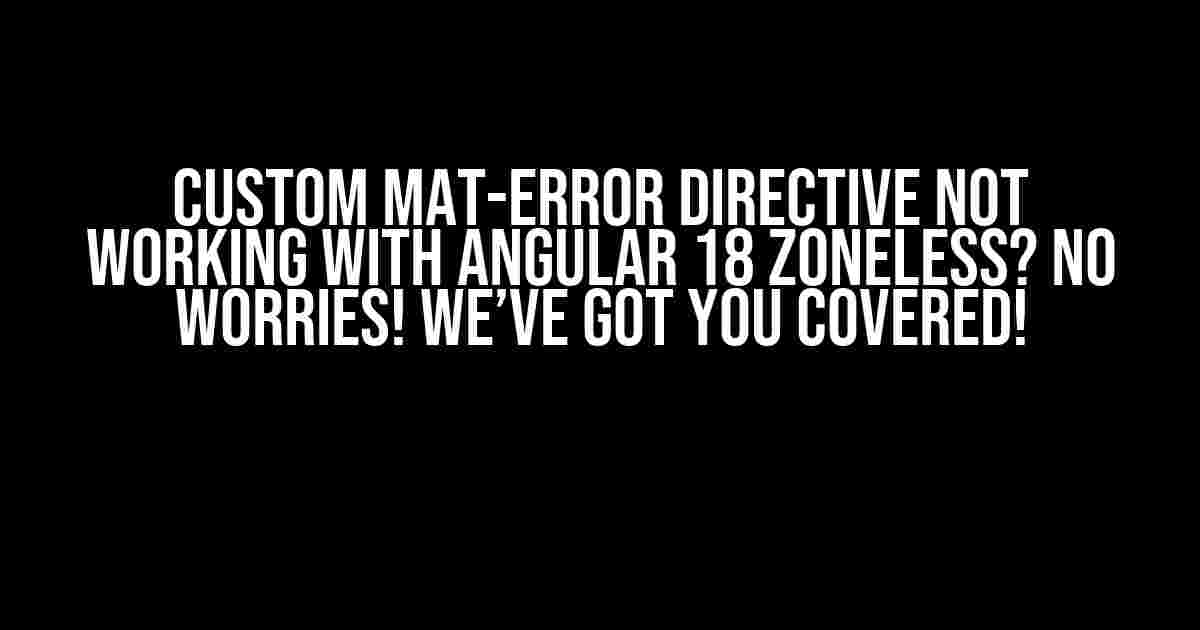Welcome to our comprehensive guide on troubleshooting the pesky issue of custom mat-error directives not working with Angular 18 zoneless. We’ll dive deep into the world of Angular and Material Design, exploring the reasons behind this problem and providing you with step-by-step solutions to get your custom mat-error directive up and running in no time!
What is the problem, exactly?
When you create a custom mat-error directive in Angular 18, you might find that it’s not working as expected when using Zoneless mode. This can be frustrating, especially when you’re trying to create a seamless user experience for your application. The problem lies in the way Zoneless mode handles change detection and how it affects the mat-error directive.
Understanding Zoneless mode in Angular 18
Zoneless mode is a new feature introduced in Angular 18, which allows for better performance and reduced memory usage. It achieves this by disabling the Zone.js library, which is responsible for detecting changes in the application and notifying the framework to perform change detection. While this sounds great, it can lead to issues with certain directives, like the mat-error directive.
The role of the mat-error directive
The mat-error directive is a built-in directive in Angular Material that displays error messages for form controls. It’s an essential component of any Angular application, as it provides users with feedback on the validity of their input. When you create a custom mat-error directive, you’re essentially overriding the default behavior of the built-in directive to meet your specific requirements.
Solutions to get your custom mat-error directive working with Angular 18 zoneless
Don’t worry, we’ve got several solutions to help you overcome this issue! Follow these steps, and you’ll be on your way to a fully functional custom mat-error directive:
Solution 1: Use the `ChangeDetectorRef` to detect changes manually
In Zoneless mode, the ChangeDetectorRef is the only way to detect changes manually. You can inject the ChangeDetectorRef into your custom mat-error directive and call the `markForCheck()` method to notify the framework of changes.
import { Directive, ChangeDetectorRef } from '@angular/core';
import { MatError } from '@angular/material/form-field';
@Directive({
selector: '[appCustomMatError]'
})
export class CustomMatErrorDirective {
constructor(private cdr: ChangeDetectorRef) { }
ngOnChanges(changes: SimpleChanges) {
if (changes.errors) {
this.cdr.markForCheck();
}
}
}Solution 2: Use the ` NgZone` to run change detection manually
Another approach is to use the NgZone service to run change detection manually. You can inject the NgZone service into your custom mat-error directive and call the `run()` method to detect changes.
import { Directive, NgZone } from '@angular/core';
import { MatError } from '@angular/material/form-field';
@Directive({
selector: '[appCustomMatError]'
})
export class CustomMatErrorDirective {
constructor(private ngZone: NgZone) { }
ngOnChanges(changes: SimpleChanges) {
if (changes.errors) {
this.ngZone.run(() => {
// Run change detection manually
});
}
}
}Solution 3: Disable Zoneless mode for the specific component
If the above solutions don’t work for you, you can disable Zoneless mode for the specific component that uses the custom mat-error directive. You can do this by adding the `@Component` decorator with the `zoneless: false` property.
import { Component } from '@angular/core';
@Component({
selector: 'app-my-form',
template: `
<form [formGroup]="myForm">
<mat-form-field>
<input matInput formControlName="username">
<mat-error appCustomMatError>{{ 'Username is required' }}</mat-error>
</mat-form-field>
</form>
`,
zoneless: false
})
export class MyFormComponent {
// ...
}Common pitfalls to avoid
When working with custom mat-error directives and Angular 18 zoneless, there are some common pitfalls to avoid:
-
Not using the `ChangeDetectorRef` or `NgZone` to detect changes manually
If you don’t use one of these services to detect changes, your custom mat-error directive won’t work as expected in Zoneless mode.
-
Not disabling Zoneless mode for the specific component
If you don’t disable Zoneless mode for the component that uses the custom mat-error directive, it won’t work as expected.
-
Using the wrong lifecycle hook
Make sure you’re using the correct lifecycle hook (e.g., `ngOnChanges`) to detect changes and update your custom mat-error directive.
Conclusion
In conclusion, getting your custom mat-error directive to work with Angular 18 zoneless mode requires a deep understanding of how Zoneless mode affects change detection and how to overcome these issues. By using the solutions outlined in this article, you should be able to create a fully functional custom mat-error directive that works seamlessly with Angular 18 zoneless mode.
Additional resources
If you’re looking for more information on Angular 18 and Material Design, check out these additional resources:
| Resource | Description |
|---|---|
| Angular Documentation | The official Angular documentation, covering everything from getting started to advanced topics. |
| Angular Material Documentation | The official Angular Material documentation, covering components, directives, and more. |
| Stack Overflow – Angular Tag | A wealth of knowledge on Angular-related topics, including custom mat-error directives and Zoneless mode. |
We hope this comprehensive guide has helped you overcome the challenges of getting your custom mat-error directive to work with Angular 18 zoneless mode. Happy coding!
Frequently Asked Question
Get the answers to the most commonly asked questions about custom mat-error directive not working with Angular 18 zoneless.
Why is my custom mat-error directive not working with Angular 18 zoneless?
The reason your custom mat-error directive is not working with Angular 18 zoneless is because Angular 18 uses the Ivy renderer, which has a different change detection mechanism compared to previous versions. This change can break custom directives that rely on the old change detection mechanism.
How do I debug my custom mat-error directive in Angular 18 zoneless?
To debug your custom mat-error directive in Angular 18 zoneless, you can use the Angular DevTools to inspect the component tree and check if your directive is being applied correctly. You can also use the browser’s developer console to check for any errors or warnings related to your directive.
Can I use the same custom mat-error directive in Angular 18 zoneless that I used in previous Angular versions?
It’s unlikely that your custom mat-error directive will work as-is in Angular 18 zoneless, due to the changes in the change detection mechanism. You may need to modify your directive to work with the Ivy renderer and the zoneless architecture.
What are some common issues I might encounter when using custom mat-error directive in Angular 18 zoneless?
Some common issues you might encounter when using custom mat-error directive in Angular 18 zoneless include errors related to change detection, issues with directive lifecycle hooks, and problems with directive rendering.
Are there any alternative approaches to custom mat-error directive in Angular 18 zoneless?
Yes, instead of using a custom mat-error directive, you can use the built-in error handling mechanisms provided by Angular, such as the `MatError` directive and the `errorStateMatcher` property.


